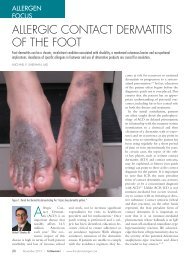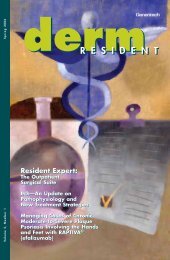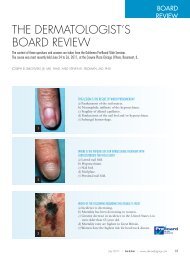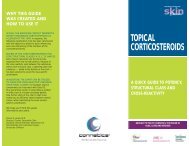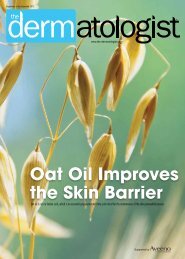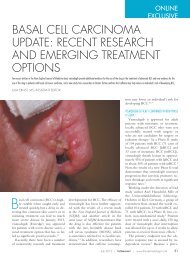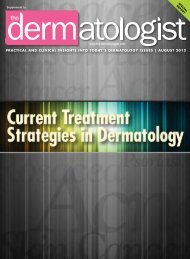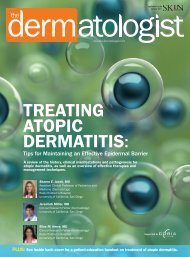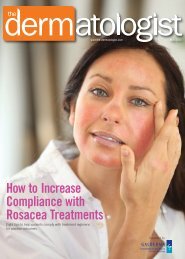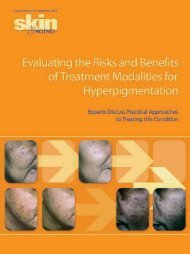Download PDF - The Dermatologist
Download PDF - The Dermatologist
Download PDF - The Dermatologist
You also want an ePaper? Increase the reach of your titles
YUMPU automatically turns print PDFs into web optimized ePapers that Google loves.
FA L L C L I N I C A L D E R M AT O L O G Y C O N F E R E N C E P R O C E E D I N G S<br />
Unlike anti-inflammatory dose doxycycline, doxycycline<br />
100 mg daily administered over a 2-week period has been<br />
shown to select for multiple resistant organisms within 7 days,<br />
with more than 32.2% of organisms obtained from nasopharyngeal<br />
cultures demonstrating resistance to doxycycline as<br />
compared to 2.2% at baseline. Doxycycline 50 mg once daily<br />
achieves serum levels that exceed the minimum inhibitory<br />
concentration (MIC) of several bacteria for 2 to 4 hours.<br />
A study evaluating the combination of metronidazole gel 1%<br />
( M e t roGel 1%) and anti-inflammatory dose doxycycline<br />
(Oracea), both used once daily, confirmed that the combination<br />
regimen produced superior therapeutic benefit as compared to<br />
topical metronidazole alone in patients with inflammatory<br />
rosacea. After 4 weeks, the combination regimen pro d u c e d<br />
essentially the same reduction in inflammatory lesions that was<br />
achieved with metronidazole gel 1% over 12 weeks (F i g u re 7) .<br />
A recent trial demonstrated that azelaic acid gel 15%<br />
(Finacea) once daily is therapeutically equivalent to twicedaily<br />
application in subjects with inflammatory ro s a c e a<br />
(F i g u re 8). Study endpoints utilized quantitative, qualitative,<br />
and static assessments, including lesion count evaluations<br />
and global assessments. Once-daily use of azelaic acid gel<br />
15% is more likely to be associated with optimal compliance<br />
and offers a cost benefit over time as compared to<br />
twice-daily application.<br />
T R O L A M I N E - C O N TAINING TO P I C A L E M U L S I O N<br />
Trolamine-containing topical emulsion (Biafine) is an oil-inwater<br />
formulation that has been used for more than 3 decades<br />
in both the United States and Europe. <strong>The</strong> mechanism of<br />
action of trolamine-containing topical emulsion appears to be<br />
p romotion of an increase in the number of macro p h a g e s<br />
recruited to the injury site, thereby reducing the time needed for<br />
healing. Macrophages promote wound healing and serve a<br />
central role in directing the course and pro g ression of the<br />
wound-healing process. <strong>The</strong>rapeutic applications for tro l a m i n e -<br />
containing topical emulsion include full-thickness wounds,<br />
superficial wounds, including those that are postoperative, dermal<br />
ulcers, radiation dermatitis, minor abrasions, actinic keratosis<br />
treatment sites after cryotherapy, and wounds that<br />
re q u i re second-intention healing after dermatologic surgery.<br />
<strong>The</strong> use of trolamine-containing topical emulsion for the<br />
t reatment of radiation dermatitis has made it possible to<br />
reduce overall treatment time of chemotherapy and radiotherapy<br />
because the modalities could be administered simultaneously<br />
rather than sequentially. Additionally, tro l a m i n e - c o n t a i n-<br />
ing topical emulsion differs from topical neomycin and bacitracin<br />
because the latter 2 agents are well recognized as common<br />
causes of contact allergy. <br />
References<br />
1. Del Rosso JQ. Recently approved systemic therapies for acne vulgaris<br />
and rosacea. Cutis. 2007;80(2):113–120.<br />
2. Plott RT, Wortzman MS. Key bioavailability features of a new extendedrelease<br />
formulation of minocycline hydrochloride tablets. Cutis. 2006;78(4<br />
Suppl):6–10.<br />
3. Fleischer AB Jr, Dinehart S, Stough D, et al. Safety and efficacy of a new<br />
e x t e n d e d - release formulation of minocycline. C u t i s. 2006;78(4<br />
Suppl):21–31.<br />
4. Del Rosso JQ. Scientific panel on antibiotic use in dermatology. Submitted<br />
for publication 2008.<br />
5. Del Rosso JQ, Webster GF, Jackson M, et al. Two randomized phase III<br />
clinical trials evaluating anti-inflammatory dose doxycycline (40-mg doxycycline,<br />
USP capsules) administered once daily for treatment of rosacea. J Am<br />
Acad Dermatol. 2007;56(5):791–802.<br />
6. Webster G, Del Rosso JQ. Anti-inflammatory activity of tetracyclines.<br />
Dermatol Clin. 2007;25(2):133–135.<br />
7. Walker C, Webster GF, Del Rosso JQ. Effect of doxycycline 100 mg daily<br />
on emergence of antibiotic resistance. Presented at the Fall Clinical<br />
Dermatology Conference in Las Vegas, NV, October 18–21, 2007.<br />
8. Fowler JF Jr. Combined effect of anti-inflammatory dose doxycycline (40-<br />
mg doxycycline, USP monohydrate contro l l e d - release capsules) and<br />
metronidazole topical gel 1% in treatment of rosacea. J Drugs Dermatol.<br />
2007;6(6):641–645.<br />
9. Fleischer AB, Thiboutot D, Del Rosso JQ. Comparison of azelaic acid gel<br />
15% once daily versus twice daily in the treatment of rosacea. Presented at<br />
the World Congress of Dermatology in Buenos Aires, Argentina, October<br />
1–5, 2007.<br />
10. Data on file. Allergan Inc., Irvine, CA, 2008.<br />
11. Del Rosso JQ, Tanghetti E. <strong>The</strong> clinical impact of vehicle technology<br />
using a patented formulation of benzoyl peroxide 5%/clindamycin 1% gel:<br />
comparative assessments of skin tolerability and evaluation of combination<br />
use with a topical retinoid. J Drugs Dermatol. 2006;5(2):160–164.<br />
12. Del Rosso JQ. Study results of benzoyl peroxide 5%/clindamycin 1%<br />
gel, adapalene 0.1% gel, and use in combination for acne vulgaris. J Drugs<br />
Dermatol. 2007;6(6):616–622.<br />
13. Tanghetti E, Abramovits W, Solomon B, et al. Tazarotene versus<br />
tazarotene plus clindamycin/benzoyl peroxide in the treatment of acne vulgaris:<br />
a multicenter, double-blind, randomized, parallel-group trial. J Drugs<br />
Dermatol. 2006;5(3):256–261.<br />
14. Bikowski JB, Del Rosso JQ. Results of a case report series using<br />
tretinoin microsphere cream alone and in combination regimens for acne vulgaris.<br />
Submitted for publication 2008.<br />
15. Del Rosso JQ, Bikowski JB. Trolamine-containing topical emulsion: clinical<br />
applications in dermatology. Cutis. In press.<br />
16. Broughton G 2nd, Janis JE, Attinger CE. <strong>The</strong> basic science of wound<br />
healing. Plast Reconstr Surg. 2006;117(7 Suppl):12S–34S.<br />
S U P P L E M E N T T O S K I N & A G I N G • M A R C H 2 0 0 8 • 7



